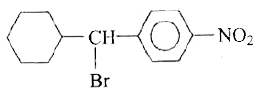The rate of elimination is fastest in
Ph−CH2−CH2−F
Ph−C∣∣O−CH2−CH2−F
Ph−O−CH2−CH2−F
CH3−CH2−CH2−F
The correct Answer is:B
To determine which compound has the fastest rate of elimination, we need to analyze the stability of the carbon ion intermediate formed during the elimination reaction. The stability of this carbon ion is influenced by the presence of electron-withdrawing or electron-donating groups.
1. Identify the Compounds: The question provides four options, each containing a fluoride group. We need to analyze each compound to determine the effect of substituents on the rate of elimination.
2. Understanding Elimination Mechanism: In alkyl fluorides, elimination reactions typically proceed through a carbon ion intermediate. The stability of this carbon ion is crucial for the rate of elimination.
3. Evaluate Each Compound:
- Compound A: pH CH2 CH2F
- The beta carbon has a phenyl group (pH) which is not an electron-withdrawing group. This does not significantly enhance the rate of elimination.
- Compound B: pH C(=O) CH2 CH2F
- The beta carbon has a carbonyl group (C=O), which is a strong electron-withdrawing group. This enhances the stability of the carbon ion, thus increasing the rate of elimination.
- Compound C: pH O CH2 CH2F
- The beta carbon has an -O (phenolic) group which is an electron-donating group. This decreases the stability of the carbon ion, leading to a slower rate of elimination.
- Compound D: CH3 CH2 CH2F
- The beta carbon has a methyl group (CH3) which is also an electron-donating group. This further decreases the stability of the carbon ion, resulting in a slower rate of elimination.
4. Conclusion: Among the four compounds, Compound B (pH C(=O) CH2 CH2F) has the strongest electron-withdrawing group, which stabilizes the carbon ion intermediate the most. Therefore, it has the fastest rate of elimination.
Final Answer:
The rate of elimination is fastest in Compound B (pH C(=O) CH2 CH2F).
---
- Compound A: pH CH2 CH2F
- The beta carbon has a phenyl group (pH) which is not an electron-withdrawing group. This does not significantly enhance the rate of elimination.
- Compound B: pH C(=O) CH2 CH2F
- The beta carbon has a carbonyl group (C=O), which is a strong electron-withdrawing group. This enhances the stability of the carbon ion, thus increasing the rate of elimination.
- Compound C: pH O CH2 CH2F
- The beta carbon has an -O (phenolic) group which is an electron-donating group. This decreases the stability of the carbon ion, leading to a slower rate of elimination.
- Compound D: CH3 CH2 CH2F
- The beta carbon has a methyl group (CH3) which is also an electron-donating group. This further decreases the stability of the carbon ion, resulting in a slower rate of elimination.
The rate of elimination is fastest in Compound B (pH C(=O) CH2 CH2F).
Topper's Solved these Questions
- ORGANIC REACTION MECHANISMS-IVBOOK - RESONANCE ENGLISHCHAPTER - ORGANIC REACTION MECHANISMS-IVEXERCISE - APSP PART-2
17 Videos
- ORGANIC REACTION MECHANISMS-IVBOOK - RESONANCE ENGLISHCHAPTER - ORGANIC REACTION MECHANISMS-IVEXERCISE - APSP PART-3
22 Videos
- ORGANIC REACTION MECHANISMS-IVBOOK - RESONANCE ENGLISHCHAPTER - ORGANIC REACTION MECHANISMS-IVEXERCISE - Exercise-3 Part-2 JEE (MAIN ) ONLINE PROBLEMS
10 Videos
- ORGANIC REACTION MECHANISMS - IIBOOK - RESONANCE ENGLISHCHAPTER - ORGANIC REACTION MECHANISMS - IIEXERCISE - APSP Part - 3
22 Videos
- PERIODIC TABLE & PERIODICITYBOOK - RESONANCE ENGLISHCHAPTER - PERIODIC TABLE & PERIODICITYEXERCISE - ORGANIC CHEMISTRY(BASIC CONCEPTS)
27 Videos
Similar Questions
Knowledge Check
The rate of Snl reaction is fastest with :
A B
B C
C D
D
SN1 reaction is fastest in
ACH3CH2BrBCH3−CH∣Cl−CH3CCH3−CH3C∣∣CH3−ClDCH3−CH∣CH2∣CH3−ClThe abstraction of proton will be fastest in which carbon in the following compound?
 AXBYCZDP
AXBYCZDP


